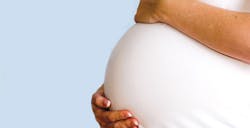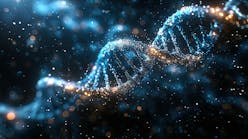Screening for genetic abnormalities in a prenatal context predominantly makes use of G-banded karyotyping or fluorescence in situ hybridization (FISH) analysis. Significant advances have been made in microarray technology, particularly for diagnostic testing in prenatal screening,1 including bacterial artificial chromosome (BAC) clone arrays, oligonucleotide array comparative genomic hybridization (oligo aCGH), and single nucleotide polymorphism (SNP) chips.
aCGH in prenatal screening
The first prenatal diagnostic tool is the ultrasound which, if abnormal, is traditionally followed by karyotyping and/or FISH analysis. This uses cultured samples such as amniotic fluid and chorionic villi obtained from invasive procedures in high-risk pregnancies where termination of an unhealthy fetus is an option.2,3
Karyotyping can detect chromosomal anomalies at the microscopic level of 5Mb with 35% accuracy.4,5 It can be a lengthy process, with 10 to 14 days required to obtain results.6 Labor-intensive FISH technology attaches DNA probes specific to certain regions of the chromosome to the sample DNA, which is then stained with fluorescent dye, effectively “painting” a region of a chromosome.
aCGH can detect genome-wide chromosomal imbalances undetected by karyotyping.3-5 Between two percent and 10 percent of abnormal ultrasound prenatal screens and normal karyotype results could benefit from aCGH tests, which most laboratories will do as good medical practice.1,5
Phenotype is unclear on an ultrasound, making the use of aCGH in a prenatal setting difficult. This complicates interpretation of results regarding incomplete penetrance or variable expressivity.6
What can be detected with aCGH
Karyotyping is superior at detecting low-level mosaicism, some ploidies, balanced but potentially pathogenic rearrangements, and de-novo heterozygous pathogenic mutations. However, some of these missed diagnoses can be overcome by using the relevant DNA reference material.3,5,9
Genomic copy number variations (CNVs—the loss or gain of genomic materials that are greater than 1kb—are a common cause of polymorphisms, but are rarely found to be pathogenic.3,7 Many clinically relevant CNVs are associated with neurocognitive alterations, such as epilepsy and intellectual disabilities. More recently, cell-free DNA from maternal blood samples has proven useful when testing for these.2
CMA technology can detect all the common trisomies, cryptic microdeletions (congenital heart defects, autism spectrum disorders, etc.), microduplications (an underweight fetus, schizophrenia, etc.), subtelomeric rearrangements, and reciprocal translocations.3,7,9 Chromosomal abnormalities, causing unexplained developmental delay and multiple congenital anomalies, can also be detected and diagnosed prenatally through the use of microarrays.2,3,7
The clinical interpretation of CNVs is currently based on incomplete, albeit steadily growing, knowledge, resulting in more CNVs of unknown significance being detected. The evidence isn’t comprehensive enough to make decisions regarding termination, a fact that should be taken into consideration when analyzing prenatal samples.9
Microarray technology
aCGH technology is used for both BAC arrays and oligo aCGH, while SNP array technology discriminates between the two possible SNP alleles expected in a certain position within the genome.6 Automation improves diagnostic quality, and integrated analytical software packages are used to normalize data, statistically analyze samples, and assign clinical meaning.3,4,7,10
aCGH requires gender-matched samples and reference DNA; thus the gender of the fetus is required for prenatal screening before testing.3,4,6 The test DNA and control samples are fluorescently labelled before being hybridized to the microarray slide, containing either BAC or oligonucleotide probes. Probe quantity can be between tens of thousands and a few million.2,4,6
The resolution depends on the number and size of the probes on the array. Each spot on the slide is a probe representing a specific locus in the genome.3,6 The DNA binds to probes with a complementary sequence and is then scanned, and the fluorescence of each dye is measured. An equal ratio of sample and control fluorescent dye indicates a normal copy number. A higher intensity dye for the control or sample would indicate a deletion or duplication in the test DNA.2,6
When using SNP platforms, only patient DNA is fluorescently labelled and hybridized onto a microarray slide; therefore, knowing the gender of the fetus isn’t necessary. Each spot on the slide represents either the A or B allele for a specific locus. The DNA binds to a complementary sequence, the slide is scanned, and the absolute intensity of fluorescence on each probe is measured.2,6 A heterozygous locus (AB) has equal intensity for each allele, while a homozygous locus (AA or BB) has greater intensity on the allele that is present.
SNP chips are considered superior for detecting uniparental disomy and copy neutral loss of heterozygosity. However, this has been mostly resolved by the inclusion of SNP probes in aCGH arrays.2,7
Array designs can be targeted, whole-genome, or whole-genome and targeted. Targeted arrays focus on a particular region of the genome, but aren’t commercially available. Whole-genome arrays include probes that correspond with points along the entire genome.6 Commercially available whole-genome array designs contain up to one million genomic fragments.3 Most such designs are whole-genome and targeted, providing a backbone of probes along the entire genome, with targeted regions focusing on genes of clinical significance. The targeted regions are constantly being updated.6
BAC arrays
BAC platforms need only 50ng starting material, making them ideal for prenatal screening, where adequate sample quantities are often difficult to obtain. BAC clones are 100-150kb long, giving a good profile from potentially poor quality prenatal DNA. The average whole genome resolution of BAC arrays is 0.5 to 1Mb, which, while 10 times the resolution of karyotyping, is still lower than CMA. BAC array protocols take one to 1.5 days, giving the potential for fast results. A report could be completed within three days of sample receipt.6
The disadvantage of using BAC arrays in a prenatal setting is that interpretation is difficult and relatively inconclusive. This is potentially harmful, as vague results may lead to the termination of healthy pregnancies.6
Throughput is slow and labor-intensive in BAC arrays, and costly for laboratories with many samples. Therefore, they are most appropriate for use in laboratories with a low number of weekly prenatal samples. The number of commercially available BAC platforms is limited.6
Oligonucleotide CGH arrays
Good results can be obtained from 500ng of starting DNA material in an oligo aCGH. This is problematic, since quality prenatal samples are difficult to obtain in such quantities. Oligonucleotide probes are much shorter than BAC probes, at approximately 50bp to 60bp long, making their resolution higher. The minimum recommended resolution is 400kb, which gives a better description of breakpoints and more precise delineation of the gene content.6
Oligo aCGH is more sensitive than BAC clone arrays.7 The drawback of higher resolution, however, is increased rates of CNV detection with unknown significance. As the databases are updated, this will become less of an obstacle.6
There are a number of commercially available oligo aCGH platforms. The greater the probe density, the more samples can be run at the same time; up to eight samples can be tested per slide, lowering the cost per sample and improving turnaround time. This is particularly useful for laboratories that receive large numbers of weekly samples. The oligo aCGH platform protocols take 1.5 to two days, allowing four days from sample receipt to final report. However, if two or more samples are tested at the same time, this gives a faster turnaround.6
SNP arrays
The required starting material is 200 to 250ng of DNA. SNP platforms tend to have the highest density of oligonucleotide probes, at 25bp to 50bp long. Resolution can be higher in targeted areas.6 CNVs and delineation of breakpoints are more accurately determined with SNP arrays, and they are adept at identifying triploidy and diploidy-triploidy mosaicism, which are relatively frequently found in prenatal samples. Maternal cell contamination and loss of heterozygosity is also identifiable using SNP arrays.2,6
The drawbacks of SNP platforms are similar to those of oligo aCGH; more CNVs of unknown significance are identified. Furthermore, segmental duplications are often poorly covered, or not covered at all, due to the non-random distribution of SNPs in the genome.6
There are a number of commercially available SNP platforms, which can handle up to 24 samples per batch. Protocols take three to five days, with a report possible within five to seven days. While this is the most time-consuming of the microarrays, it is still faster than karyotyping.6
Software options
A web-based database, containing an ever-expanding collection of CNVs of known or uncertain significance, provides a useful diagnostic aid for interpreting results.7 Available databases include the Database of Genomic Variants (DGV), International Standards for Cytogenomic Arrays (ISCA), DatabasE of Chromosomal Imbalance and Phenotype in Humans using Ensembl Resources (DECIPHER), and Online Mendelian Inheritance in Man (OMIM).6,7,9
Software designed for automating breakpoint detection and statistical analysis interprets microarray data, making analysis quicker and more accurate. However, it needs to have access to all major genome browsers and online CNV databases. If this information comes embedded in the program, the software will require frequent updating. Analysis software should also be capable of creating and storing an in-house database formulated from previous laboratory results and interpretations.6
Effective software uses a number of computational algorithms to analyze samples, such as hidden Markov model (HMM), circular binary segmentation (CBS), gain and loss analysis of DNA Gaussian-based approach (GLAD), and “cluster along chromosomes” (CLAC). HMM is best for detecting small aberrations, but has a high false-positive rate. The latter three methods model discrete losses and gains in the copy number, before significance is assessed through a permutation reference distribution. While CBS is considered the better of the three for detecting breakpoints and copy number alterations, it cannot identify single clone aberrations and isn’t efficient for whole-genome analysis. CLAC is more computationally efficient and controls the false detection rate of breakpoints at a predetermined level.10It is possible to apply filters to the microarray results, ignoring CNVs of certain sizes. However, this doesn’t necessarily prevent the detection of benign CNVs or CNVs of unknown significance, and it can lead to incomplete results through the exclusion of clinically significant anomalies.6
Staff experience issues
To successfully implement prenatal screening with aCGH, staff with current or previous experience in the chosen platform are essential. Practical experience of platform operations and protocols will make interpretation and troubleshooting smoother, simplifying workflow and decreasing labor costs.
If a laboratory handles postnatal samples, the same platform can be used for prenatal screening.6 For a laboratory that is already involved in prenatal screening, the addition of a microarray would be beneficial. Lab leaders should be selective when choosing a platform, selecting one that best suits the skills and experience of staff.
Making the call
The use of microarrays seems to be steadily progressing toward replacing karyotyping for prenatal screening. However, it is likely to be used in conjunction with karyotyping for the foreseeable future, at least until the results are more inclusive and conclusive, as the anomalies which cannot be detected by microarrays, or have unknown clinical significance, cannot be disregarded.9
The costs of the platforms, reagents, and set-up vary, depending largely on the resolution required.6 However, many aCGH samples don’t need to be cultured and a number of samples can be included in the same array, reducing the time and cost required to run the test.2,3 If the cost of labor is too great, it might be wise to consider automated systems and user-friendly analysis software.6
Regardless of the technological progress in prenatal genetic screening, the need remains for low-cost, simple, and accurate techniques.7 The decision of which microarray to use for prenatal screening depends on the platform and resolution that is needed, as well as staff experience.
References
-
Cavalli P, Cavallari U, Novelli A. Array CGH in routine prenatal diagnosis practice. Prenatal diagnosis .2012; 32(7):708-709. doi:10.1002/pd.3845
-
Wapner R, Levy B. The impact of new genomic technologies in reproductive medicine. Discovery Medicine. 2014; 17(96):313-318. http://www.discoverymedicine.com/Ronald-J-Wapner/2014/06/the-impact-of-new-genomic-technologies-in-reproductive-medicine/. Accessed March 21, 2015.
-
Zuffardi O, Vetro A, Brady P, Vermeesch J. Array technology in prenatal diagnosis. Seminars in Fetal & Neonatal Medicine. 2011;16:94-98. doi:10.1016/j.siny.2010.12.001.
-
Yin A, Lu J, Liu C, et al. A prenatal missed diagnosed case of submicroscopic chromosomal abnormalities by karyotyping: the clinical utility of array-based CGH in prenatal diagnostics. Mol Cytogenet.http://www.molecularcytogenetics.org/content/7/1/26. Accessed March 21, 2015.
-
Manolakos E, Kefalas K, Vetro A. et al. Prenatal diagnosis of two de novo 4q35-qter deletions characterized by array-CGH. Mol Cytogenet. 2013;6:47.
-
Karampetsou E, Morrogh D, Chitty L. Microarray technology for the diagnosis of fetal chromosomal aberrations: which platform should we use? J. Clin. Med. 2014;3(2):663-678.
-
Wei Y, Xu F, Li P. Technology-driven and evidence-based genomic analysis for integrated pediatric and prenatal genetics evaluation. J Genetics and Genomics. 2013; 40:1-14. http://dx.doi.org/10.1016/jjgg. 2012.12.004. Accessed March 21, 2015.
-
Carter N. Methods and strategies for analyzing copy number variation using DNA microarrays. Nature Genetics. 2007;39:16-21.
-
Novelli A, Grati FR, Ballarati L, et al. Microarray application in prenatal diagnosis: a position statement from the cytogenetics working group of the Italian Society of Human Genetics (SIGU), November 2011. Ultrasound Obstet Gynecol. 2012;39: 384-388.
-
Karimpour-Fard A, Dumas L, Phang T, Sikela JM, Hunter LE. A survey of analysis software for array-comparative genomic hybridisation studies to detect copy number variation. Hum Genom. 2010;4(6):421-427.
-
Nicola Davies, MSc, PhD, is a health psychologist, writer, and CEO of London-based Health PsychologyConsultancy Ltd.
The evolution of prenatal genetic screening
In 2015, the options for prenatal genetic screening and testing far surpass those available even five years ago. The choices can seem overwhelming, but pre-test counseling with an educated provider can assist in the navigation of these complex scenarios and help a pregnant woman decide what, if any, screening is right for her.
Maternal age
The first prenatal screen for chromosome abnormalities was simple: how old is the mother? The incidence of chromosome abnormalities such as trisomy 21 (Down syndrome), trisomy 18, and trisomy 13 increases with maternal age. At age 35 at delivery, there is an approximate 1 in 200 chance of having a baby with one of these chromosome abnormalities.
Maternal serum screening (MSS)
Over the years, a number of circulating analytes were found to provide additional information about risks for chromosome abnormalities and certain birth defects. Maternal serum screening goes by various names, typically differentiating when and how the testing is performed; first trimester, sequential, integrated, and contingent are the most common terms. Blood drawn in the first trimester, with or without a nuchal translucency ultrasound, provides an early risk assessment. The addition of a second blood draw in the second trimester increases the sensitivity of this screening. However, this screening still has significant limitations. MSS has a false positive rate of approximately 5% and a false negative rate of up to 15%. On average, the likelihood that a screen positive result actually represents an affected pregnancy may be less than 5%. This leads to more referrals for high-risk consultations and more invasive diagnostic testing on pregnancies that are not truly high-risk.
Noninvasive prenatal testing (NIPT)
An alternative to traditional MSS, noninvasive prenatal testing (NIPT), became clinically available in 2011. The premise of NIPT is that placental cells undergo apoptosis and release fragments of DNA into the maternal blood stream throughout pregnancy. These fragments mingle with DNA fragments from the mother’s own cells. A maternal blood draw directly ascertains DNA from the placenta, which is derived from the same cells as the fetus.
The original NIPT methodology is known as massively parallel shotgun sequencing (MPSS). This method measures the total amount of DNA from a chromosome of interest (e.g., chromosome 21) in the maternal circulation and compares this amount to a stable “reference chromosome.” If there is more DNA from the chromosome of interest than expected, this may signify a trisomy in the fetus. This technology, along with a similar targeted method, is often referred to as “counting.”
This first iteration of NIPT was offered to high-risk pregnancies and resulted in a significantly lower false positive rate than MSS. However, NIPT using the counting methodology also has limitations. Counting cannot differentiate between DNA fragments that derive from the placenta and those that are maternal in origin. Therefore, a maternal chromosome abnormality may be detected using this testing and incorrectly attributed to the fetus, particularly in the case of sex chromosome abnormalities. Second, if the pregnancy started as a twin gestation and one fetus undergoes demise, it is not possible to determine if the DNA fragments analyzed are from the ongoing pregnancy or the demised (vanishing) twin, resulting in a false positive test. Third, the counting method is unable to screen for triploidy, as each chromosome is present in three copies, and the comparative amounts of DNA would appear normal.
SNP-based NIPT
The next generation of NIPT was introduced in late 2012 and addressed the limitations inherent in the counting method. This newer methodology uses single nucleotide polymorphisms (SNPs), an approach used to identify genetic patterns or “fingerprints” that can differentiate individual DNA patterns. Proprietary algorithms generate a “best fit” model to explain the SNP data seen in the fetal haplotype, and make a chromosome copy call based on this data. Since evaluation of the maternal contribution is performed in a separate reaction, maternal chromosome issues are not incorrectly attributed to the pregnancy.
In the case of a vanished twin, the SNP profile will detect this additional data, and a result will not be generated. This is important as DNA from a vanished twin can persist even eight weeks following a demise, confounding NIPT results. The SNP technology also can screen for triploidy and has unparalleled accuracy with fetal sex determination. Advances in SNP technology for NIPT have also allowed for the detection of microdeletions. The most common of these syndromes, 22q11.2 deletion syndrome (DiGeorge), occurs in approximately one in 2,000 individuals and is associated with a number of physical and cognitive challenges that can benefit from early diagnosis and intervention.
Carrier screening
In addition to screening for chromosome abnormalities, pregnant couples are typically offered carrier screening for genetic conditions such as cystic fibrosis (CF). Carrier screening panels have now grown to include dozens, even hundreds, of less common genetic conditions. Some couples may value having this extensive carrier screening performed, while others may not consider this screening a priority.
Diagnostic testing
The only way to diagnose a chromosome abnormality or other genetic condition prenatally is by invasive testing with chorionic villus sampling (CVS) or amniocentesis. ACOG and ACMG recommend that all women be offered these procedures. However, due to increased risk of fetal loss, albeit small when performed by trained, experienced operators, many women will opt for screening. If a woman does opt for screening and receives a “screen positive” or “high-risk” NIPT result, it is imperative that follow up with the option of CVS or amniocentesis for confirmation be made available.
Great advances have been made in the last several decades in the field of prenatal diagnosis and screening. NIPT technology, however, has altered the landscape in recent years, by providing women with a screening option that reduces false positive rates from 5% to less than 1%. While NIPT remains a screening test only, rapid technological progress, particularly using SNPs, holds the promise of even greater improvements in test performance and safety.





